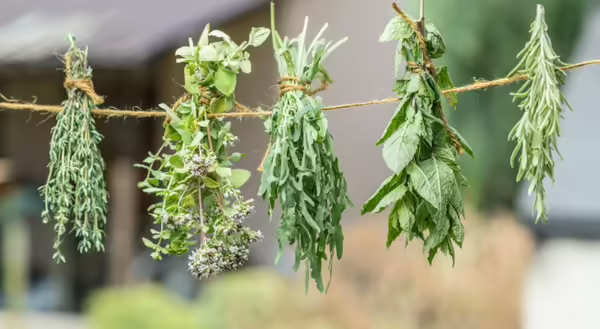
Herbs are among the easiest plants to grow, whether in a backyard garden, a small container on the patio, or indoors on a sunny windowsill. Their versatility and resilience make them a favorite for home gardeners, and many varieties thrive with regular harvesting—often producing more the more they are picked. This abundance, while delightful, can quickly exceed what can be used fresh. To make the most of your harvest, preserving herbs ensures no herbs are wasted and that you can enjoy homegrown flavor all year.
Harvesting
The species of plant will influence which plant part is being used as an herb.
If leaves are being used, the new leaves near the tip will have the most flavor. Harvest in the morning after dew has evaporated from the leaves. Harvest before the plant has developed flowers to avoid diminished flavor quality. Leaves should be free from damage or blemish. Once harvested, rinse leaves with cool water and pat dry with a clean towel or use a salad spinner to remove excess water. Herbs popular for their leaves include basil, dill, cilantro, oregano, rosemary, sage, and thyme.
If seeds and fruits are being utilized, harvest them after they reach maturity. Harvest when the dew has dried. Herbs popular for their seeds or fruits include fennel, dill, nigella, poppy, and parsley.
Only collect as much as you can preserve at one time. For the best flavor and color, herbs should be utilized or preserved as soon as possible following harvest.
Freezing
Fresh, washed leaves can be frozen whole or in smaller pieces. Blanching is optional but not necessary. Blanching typically reduces the flavor but better preserves the color.
Freeze whole leaves and stems by spreading them on a cookie sheet in a single layer and placing them in the freezer. As soon as the leaves are frozen, place the leaves in a labeled freezer bag. Do not allow it to thaw while transferring to the freezer bag. If allowed to thaw, leaves will freeze together, making use more challenging.
Herb ice cubes can be frozen by chopping herbs into small pieces and placing approximately 1 teaspoon in each section of an ice cube tray. Fill each segment with water and place it in the freezer. Once frozen, store in a freezer bag labeled with the contents. Use in soups or stews, sauces, or other cooked dishes.
Drying
The method of drying depends on the moisture content of the herb. Tender herbs, such as basil, mints, chives, and dill, have higher moisture content and need to be dried more quickly to avoid mold. Herbs can be tied in small clusters and hung to dry in areas of low humidity and adequate air circulation. Avoid dust on leaves or debris falling from the cluster by placing it in a brown paper bag with ventilation holes.
Herbs can be spread on a tray of paper towels or a cookie tray for air drying. Keep the tray in a well-ventilated area for five to ten days. Check often and change paper towels if necessary.
Sturdy herbs such as sage, thyme, rosemary, cilantro, and parsley are easily dried by tying them into small bundles and hanging them in a well-ventilated area.
Herbs are sufficiently dry when the leaves are brittle and crumble when touched. Store in an airtight container in a cool, dry, and dark location.
Dried herbs typically have a stronger flavor, three to four times stronger than fresh herbs. When using as a substitute for fresh, use one-quarter to one-third the amount called for in the recipe. Use dried herbs within one year for the best flavor.
Good Growing Fact of the Week: Oven drying is not recommended. Even the lowest temperature setting is too high and destroys the flavor and color of the herbs.
Thank You for Reading!
Sign up for our emails! Want to get notified when new Good Growing posts are available? SIGN ME UP
Give us feedback! How helpful was this information (click one): Very helpful | Somewhat helpful | Not very helpful
MEET THE AUTHOR
Emily Swihart is a horticulture educator with University of Illinois Extension, serving Henry, Mercer, Rock Island, and Stark counties since 2021. Emily provides horticulture programming with an emphasis on the home gardener, the urban forest, native plant ecosystems, and landscape design. Additional responsibilities include supporting local county Master Gardener and Master Naturalist volunteers - providing training, continuing education, advanced training, and their involvement in seasonal events and community outreach programs.